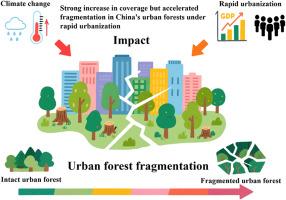快速城市化背景下,中国城市森林盖度显著增加,但破碎化加速
IF 5.4
2区 地球科学
Q1 GEOGRAPHY
引用次数: 0
摘要
城市森林破碎化破坏了城市生态系统的完整性、稳定性和生态功能。然而,在快速城市化背景下,其在国家尺度上的时空动态和驱动机制仍未得到充分认识。基于构建的UFF指数,本研究量化了2000 - 2022年中国291个城市UFF的演变。采用二次多项式拟合方法确定不同气候带和城市级别关键驱动因素的临界阈值,并利用Geodetector模型对这些驱动因素进行进一步研究。结果表明:中国城市森林平均覆盖率为20.32%,其中小城市和亚热带季风气候区城市森林覆盖率较高,总体呈上升趋势;全国平均UFF指数约为0.59,破碎化程度最高的是小城市和亚热带季风区。在大城市和小城市,特别是在温带季风气候区,UFF都显示出持续加剧的趋势。在UFF驱动因素中观察到明显的阈值效应:低于一定水平,驱动因素的增加并没有减少碎片化,甚至可能加剧碎片化;超过阈值后,碎片化显著减少。此外,不同气候区、不同城市对UFF的主要驱动因素存在差异。值得注意的是,自然和人为因素之间的相互作用比个体因素具有更强的解释力。这些发现增强了我们对快速城市化背景下城市森林的认识,并为可持续城市森林管理提供了有价值的见解。本文章由计算机程序翻译,如有差异,请以英文原文为准。

Strong increase in coverage but accelerated fragmentation in China's urban forests under rapid urbanization
Urban forest fragmentation (UFF) undermines the integrity, stability, and ecological functioning of urban ecosystems. However, under rapid urbanization, its spatiotemporal dynamics and driving mechanisms at the national scale remain insufficiently understood. Based on a constructed UFF index, this study quantifies the evolution of UFF across 291 Chinese cities from 2000 to 2022. Quadratic polynomial fitting was used to identify critical thresholds of key drivers across various climate zones and city levels, and the Geodetector model was employed to further investigate these driving factors. Results indicate that the average urban forest coverage in China was 20.32 %, with higher urban forest coverage observed in small cities and subtropical monsoon climate zones, and a general upward trend over the study period. The national average UFF index was approximately 0.59, with the highest fragmentation occurring in small cities and subtropical monsoon regions. UFF has shown continuous intensification in both mega and small cities, particularly in temperate monsoon climate zones. A distinct threshold effect was observed in the drivers of UFF: below a certain level, increases in driving factors did not reduce fragmentation and may even have exacerbated it; beyond the threshold, fragmentation decreased significantly. Furthermore, the primary drivers of UFF varied by climate zone and city level. Notably, the interaction between natural and anthropogenic factors demonstrated stronger explanatory power than individual factors. These findings enhance our understanding of UFF under rapid urbanization and provide valuable insights for sustainable urban forest management.
求助全文
通过发布文献求助,成功后即可免费获取论文全文。
去求助
来源期刊

Applied Geography
GEOGRAPHY-
CiteScore
8.00
自引率
2.00%
发文量
134
期刊介绍:
Applied Geography is a journal devoted to the publication of research which utilizes geographic approaches (human, physical, nature-society and GIScience) to resolve human problems that have a spatial dimension. These problems may be related to the assessment, management and allocation of the world physical and/or human resources. The underlying rationale of the journal is that only through a clear understanding of the relevant societal, physical, and coupled natural-humans systems can we resolve such problems. Papers are invited on any theme involving the application of geographical theory and methodology in the resolution of human problems.
 求助内容:
求助内容: 应助结果提醒方式:
应助结果提醒方式:


